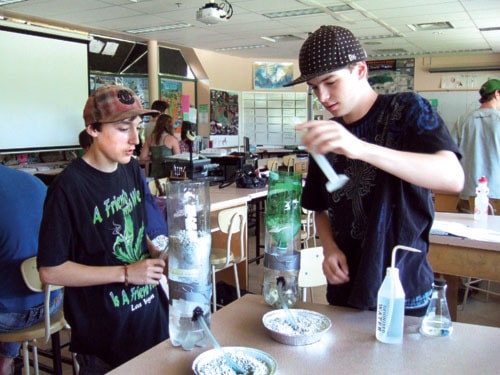It’s a room of doing, not sitting still – a room where Grade 11 students are learning about their environment and enjoying the process.
“It’s pretty entertaining – better than most classes,” says Brian Sutter. “Instead of tests, we do projects and it’s nice to learn about the local area.”
Classmate Richard Pittman agrees.
“There’s a lot of hands-on, it keeps you interested,” he says, pointing to a bowl of pebbles in which he is planning to plant seeds.
Students have built simulated wetlands with pop bottles, tubes and pebbles in the pop bottles and small bowls in order to learn about the critical importance of real-life wetlands in purifying water.
It is one of the many varied classroom projects the students have engaged in during this, the first year, of Salmon Arm Secondary’s Environmental Science 11 – The Shuswap Watershed course.
The students have conducted an on-site waste audit trash and learned that 70 to 100 per cent of North Pacific sea birds are affected by eating plastic.
They’ve discovered how different kinds of ground cover affect runoff and how rivers function.
As well as lab work, the enthusiastic students have participated in valuable field trips where they have tested water in the Shuswap watershed and collected and planted willow cuttings for streambank rehabilitation.
Equally enthusiastic science teacher Dave Ramsay introduced the curriculum he had created as part of his masters program in leadership and administration.
Ramsay says the large Shuswap Lake algae bloom in 2008 got him thinking about how water quality is critical to the planet’s health.
“There’s a lot of stuff happening out there and who’s teaching about it,” he asked himself, recognizing at the same time growing community polarization over the SmartCentres development on the Salmon River delta.
“I realized as an educator, my main priority is the water,” he says. “Then I asked myself, what’s my role?”
Ramsay says sustainability of the planet is in the hands of the people so educating decision-makers about the importance of sustainability could reduce costly conflicts such as those over SmartCentres.
“I suspect it’s been a costly event for everyone,” he says, emphasizing the need for protecting water and the ramifications of failing to do so. “But instead of conflict, we have an opportunity to work together.”
Ramsay’s designed the course to answer several questions: What is sustainability? To what extent are natural systems connected? To what extent do human activities impact the sustainability of the Shuswap Wstershed?
While they are learning the answers to these questions, students are increasing their technical knowledge, becoming engaged with the needs of the planet and potentially improving sustainable behaviour.
Ramsay says the course is a perfect fit with the school district’s green “learn it – love it - live it” motto that encourages a commitment to understanding sustainability, modelling green stewardship and implementing environmental actions in the school, district and community.
The curriculum emphasizes “three Ps” – people, planet and prosperity, a process in which environmental protection and resource conservation contributes to social well-being, economic prosperity and continuity.
Ramsay is teaching in tandem with social studies teacher Graham Gomme and has invited avid supporter and former teacher Kim Fulton, aka Dr. Fish, to help with fieldwork.
Still working his way through the first year, Ramsay is keen to share his vision of where the course could lead.
He sees the potential for developing a Grade 12 course – something his students have asked for – and the possibility of self-directed study.
“They are so darn smart and they want to learn stuff that’s real,” he says, with excitement, suggesting Okanagan College could include Shuswap Watershed studies and support “green jobs.”
“If we became known for sustainability, we could attract researchers, PhDs, people working at the college. As we grow economically, we need to grow sustainably, integrating knowledge instead of pitting one side against the other.”
Ramsay has found support for his course from many sources – RBC’s Blue Water Program, Department of Fisheries and Oceans, School District #83, Wild BC and the Kalamalka Research Forest, support that has allowed him to plan field trips and stream rehabilitation.
“I’m amazed at the level of support, this is a big ship to get underway,” he says noting the work that has gone into building infrastructure for the course and making sure it will work. “You can’t just let kids go, you have to provide an opportunity for success.”
